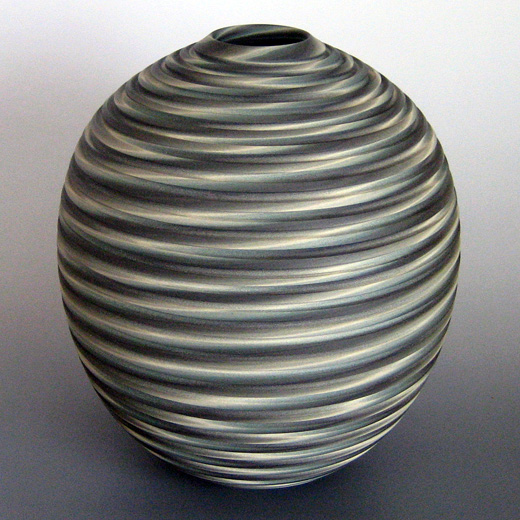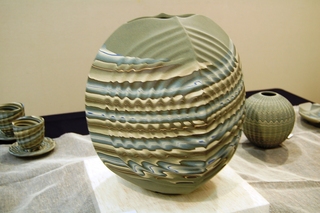IMAGES: KAMIO OGATA Google Images
LINKS:
BIO/CV: Born 1949
Ogata Kamio ,a native of the remote island of Hokkaidô, is a self-taught artist who has chosen to specialize in the extremely difficult art of neriage, or marbleized clay. Despite his lack of professional connections, Ogata is rapidly becoming recognized throughout Japan for his unrivaled mastery, creating work with layerings of more than one hundred tonalities of subtly colored clay. One such vessel is currently on view at the Metropolitan Museum of Art.
Revelant Work Experience
- 1977-1994 Worked as guidance teacher at an institution for the mentally handicapped
- 1986 Set up studio in Shinshinotsu
Exhibitions
2011
The 51th East Japan Traditional Art Craft Exhibition
2010
The 50th East Japan Traditional Art Craft Exhibition
The 3rd Contemprrary Chatou Exhibition (Ceratopia Toki in Gifu prefecture)
Ao Exhibition (Joan B Mirviss Gallery in NY)
SOFA WEST:Santa Fe2010
Solo Exhibition (Kogei Ima gallery in Tokyo)
Solo Exhibition (Rakubidou Chatoukan in Ymagata prefecture)
Solo Exhibition (Saitou Gallery in Sapporo)
2009
The 49th East Japan Traditional Art Craft Exhibition
Work entered collection of New Orleans Museum of Art (NOMA)
EASTERN DEPARTURES (Ceramic Artists of Eastern Japan in Joan B Mirviss Gallery in NY)
Solo Exhibition (Saito Gallery in Sapporo)
2008
The 48th East Japan Traditional Art Craft Exhibition
The 7th MASHIKO CERAMICS COMPETITION
2007
The 45th Anniversary ASAHI CERAMIC ART EXHIBITION
The 28th CHOZA Modern Exhibition
2006
Cool&Sophisticated:Contemporary Cermists of Eastern Japan(Ibaraki Ceramic Museum)
The 46th Traditional Art Crafts New Work Exhibition
MARUI Exhibition (Sapporo)
Work entered collection of Metropolitan Museum of Art
2005
The 3rd The Contemprrary Chatou Exhibitiont (Awarded Silver Juges)
The 45th Traditional Art Crafts New Work Exhibition (Awarded the Judges The East Japan Area)
The 18th Japan Ceramic Art Exhibition
The 52nd Japan Traditional Ceramic Exhibition
MITSUKOSHI Exhibition (Tokyo Nihonbashi)
2004
The 44th Traditional Art Crafts New Work Exhibition(1988~2011)
Akasaka Inui Gyalley Exhibition (Tokyo)
The 1st Kikuchi Biennale(Tokyo)
2003
The Form of Ceramic (Art Seramic Center in Ebetsu)
Nakamura art Salon Exhibition (Ibaraki prefecture 2005)
Become a member of The Japan Crafts Association
2002
The works of industrial artists around Sorachi “ceramic & glass”(the Yubari Museum of Art)
The studio M Private Exhibition in Tokyo
The Tokyo American Club Exhibition (Tokyo)
2001
Ginza Kogei Murata Exhibition (Tokyo)
2000
Gallery 91「Everyday Things」(NY)
http://wwwjapandesign.ne.jp/HTM/NY/0012/index2.html
Silverhawk Fine Crafts Internet Exhibition
http://www.silverhawk5.com/ogata/index.html
CRAFT COMPETITION IN TAKAOKA
The 3rd Mashiko Ceramics Competition 2000 ~Awarded the Judges Special Prize
The studio M Private Exhibition in Tokyo
Modern Chato competition ( Toki City )
1999
1998 The 2nd Mashiko Ceramics Competition ’98 ~Awarded the Judges Special Prize
1997 Group Exhibition, Tachikichi Gallery, Kyoto
1994 Atelier M. Private Exhibition, Tokyo( 1994,1996, 1998 and 2000 ,2002)
1991 Daido Gallery Private Exhibition, Sapporo(1993,1994,1996 through 2005)
1988 Traditional Art Crafts New Work Exhibition(1988 to 2006) Awarded The Hokkaido Newspaper -Prize,1988,1995
1987 All Hokkaido Art Association Exhibition, Sapporo Awarded the Fine Work Prize
Hokkaido Crafts Grand Prize’87, Sapporo
1986 Awarded the Shinshinotsu Art Prize
Chunichi International Exhibition of Ceramic Arts, Nagoya (1986 and 1987)
1985 Traditional Art Crafts New Work Exhibition, Tokyo (1985 through 2003)
JAPANESE TRADITIONAL ART CRAFTS, Tokyo (1985 and 1995、2002)
1984 All Hokkaido Art Association Exihibition, Sapporo (1984 through 2002)
We call this design Neriage or Nerikomi; different coloured clays are put together using a colouring agent.
For more than fifteen years I’ve worked with Nerikomi, first creating vases using Nerikomi and Hibiware and now moving on to making platters and sets of dishes.
I’m fascinated by the “motion” of a design, something lacking in most designs using Nerikomi. My personal theme, then, is “how to give motion”to Nerikomi. Recently, my feelings have been changing: I’d like to give expression to motion in Nerikomi to show that it, as a phenomenon, offers more than just delicacy and refinement. The outcome, I hope, will bring more emotion and feeling to the art of Nerikomi.




